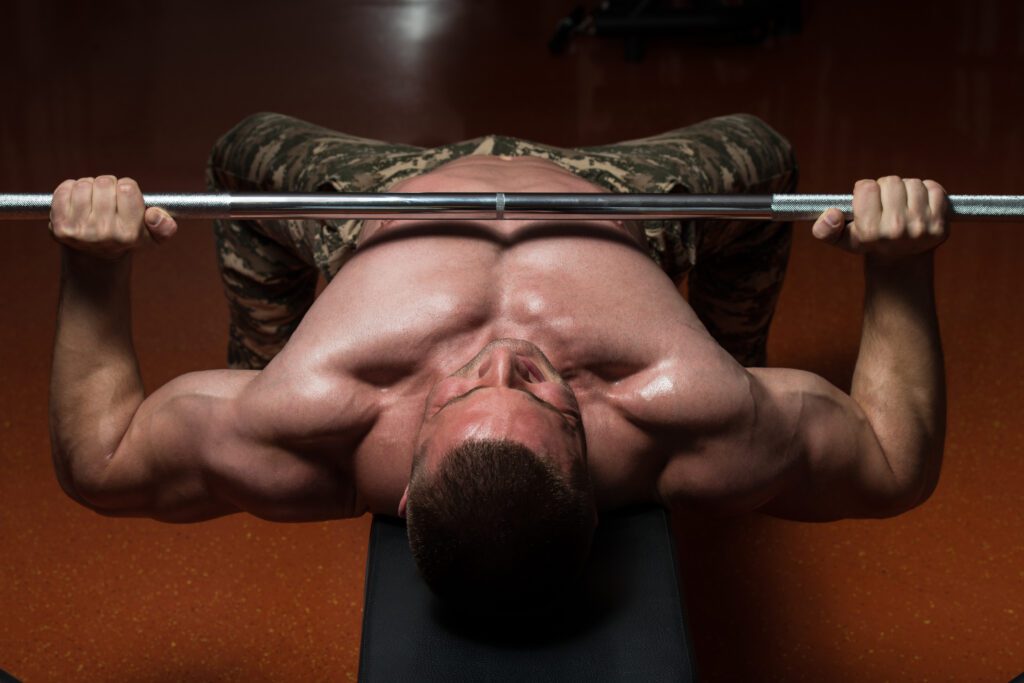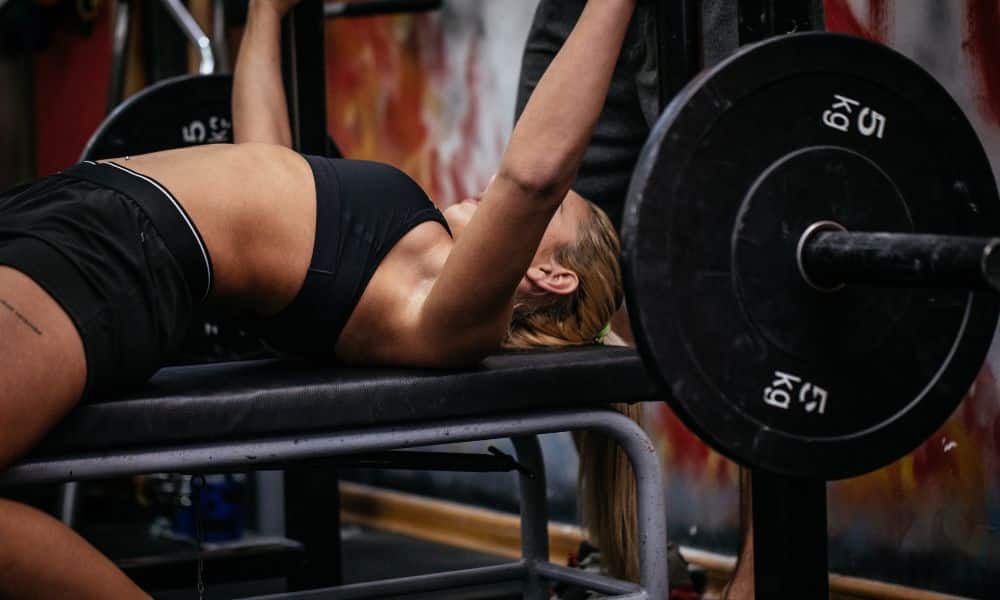How can you use a chest workout to build your chest in 30 minutes or less? Developing a muscular chest might be challenging when you don’t have enough time. Today’s bodybuilders do not spend all day in the gym but still create massive gains. So how do they do it? By concentrating on proper form, sets, reps, and rest. The primary issue with virtually all chest training routines is that they target the middle area of the chest with the same movements.
For example, they use the barbell bench press and dumbbell fly. As a result, every part of the pecs, especially the upper chest, is developed the same way. In this article, we’ll go through a chest workout, allowing you to create a thick and robust set of pecs in 30 minutes.
Try this 30 Minutes Chest Workout!
The most important factors that build the chest are volume, form, progressive overload, diet, rest, and recovery. To create the chest, you must perform 9 to 26 sets each week. Also, you must complete 8 – 12 reps at 70% to 80% of your one-repetition max.
Finally, it is best to use compound exercises to build primary and secondary muscle groups. Also, you want to develop the shoulders and triceps, so they don’t sabotage your chest workout. A chain always breaks at the weakest link, no matter where that link is located.
Volume
- 4 Exercises
- 4 Sets
- 10 Reps
- 60-second rest time
- 70 – 80% of 1rpm
Warmup
Dips are a wonderful bodyweight chest and triceps exercise that you can do in three different rep ranges: heavy, medium, and mild. All are excellent for working the chest and triceps. Also, you can superset them with isolation exercises to boost their benefits even more.
Decline push-ups, like regular push-ups, are a great bodyweight chest exercise. Performing push-ups on a decline places more stress on the chest. Like dips, these are an excellent way to work the chest with a bodyweight exercise. Also, you can superset them by combing them with other chest exercises.
Chest Workout
The most important thing about an exercise is how you perform it. Of course, everyone does the same movements. But what separates success from failure is the form you use to complete each exercise.
The only reps that count are the ones you perform correctly. Thus, the form includes time under tension, mind-to-muscle connection, and concentric, eccentric and isometric movements. So here are four chest exercises that you can use to create a massive chest:
1. Bench Press
Here is how to perform the bench press. First, lie down on the bench and spread your feet shoulder-width apart. Next, keep your back pressed against the bench throughout the lift. Thus, this will keep you stable and help you keep the weight moving in a straight line.
Third, tighten your glutes, abs, and quads before unracking the weight. Thus, this will create a stable base from which to press and help keep your back pressed against the bench. Next, slowly lower the bar to your chest. When the bar touches your chest, drive the weight back up, extending your arm without hyper-extending your elbows.
Finally, squeeze your chest at the top of the lift. Then, complete another rep. Don’t forget to press the bar along a vertical line and keep the weight under control at all times. Also, use the mind-to-muscle connection by thinking about your chest, shoulders, and triceps as your press the weight. Also, don’t forget to keep your feet on the ground and your butt, back, and head flat and squarely on the bench.
Tips –
- Use the “Widowmaker” Hold. To engage your long tricep head (crucial for the bench), pause each rep at the bottom of the movement to keep tension on your pecs.
- Train Your Triceps! Do you want a big bench? You need to train all three heads of your triceps. While doing close-grip bench presses, do a few sets of tricep pushdowns.
- Train With Chains. Adding chains to the end of a barbell during a bench press makes for a more effective lockout because it forces your chest and shoulders to work harder through the entire range of motion–meaning more muscle growth.
- Grip the Bar Correctly. A wider grip (shoulder-width or broader) will emphasize your chest, while a narrower grip will work your triceps more. Experiment to see what works best for you.
- Use a Spotter. When lifting heavy weights, it’s always a good idea to have a spotter. If you’re stuck and can’t complete the rep, they can help you get the bar back to the starting position.
2. Dumbbell Fly
Dumbbell fly is one of the best exercises for chest muscles, belonging to the “Pectoral” or “Pecs.” However, you must perform this exercise correctly not to harm your back. If you are performing it incorrectly, there is a high probability that you will experience lower back pain.
To perform the basic dumbbell, fly, lie on a flat bench, and hold a light dumbbell in each hand above your chest. Your palms should face your feet. Now lower them to the sides of your body as far as possible without arching or shrugging up your shoulder blades (you will feel it in your chest). Hold for a second, then raise the weights back to the starting position.
When lowering the weights, ensure you do not allow them to touch your chest. Touching your chest will reduce the range of motion and not work the muscles. Instead, you will feel a stretch in your chest when lowering the weights.
Tips –
- First, keep your back pressed firmly against the bench. Do not let it arch.
- Don’t allow your shoulder blades to come together (shrug up).
- Keep your elbows slightly bent. Thus, this will help reduce stress on your shoulder joint.
- Do not lock your arms at the top of the movement. Also, this will take some pressure off your chest muscles.
- Finally, ensure that you do not allow the dumbbells to touch you when lowering them (touching your chest).
- Remember that this is a challenging exercise; stop immediately if it causes pain.
- Decline Bench Press
3. Decline Bench Presses
The Decline bench press is similar to the flat bench press, so anyone comfortable doing flat benches can perform this movement. Also, this exercise trains you to press weight away from your chest towards a more horizontal line above your head. Thus, this targets your upper pectoral muscles and triceps particularly well.
On the bench set-up, put your feet on a step to create an extended range of motion. If you don’t have a decline bench press bench, you can do it with dumbbells using an incline bench press station or a flat bench with your back against a wall. Position your hands slightly wider than shoulder-width apart, and before you start the lift, take a deep breath and hold it.
Start the lift by pulling your heels into the ground and pushing your torso toward the bench, as with a pressing exercise. Keep your glutes and abdominal muscles tight to help stabilize your body. From here, slowly lower the weight towards your chest, maintaining control. Stop when your elbows reach a 90-degree angle, then press the weight back to the starting position.
If you’re having trouble maintaining control during the lowering phase, it’s a sign that you’re using too much weight. Try reducing the load and see if that makes the exercise easier to control. When doing this exercise, always be aware of your range of motion. For example, don’t let your butt come up off the bench or your elbows flare out to the sides. Instead, keep your glutes and ab muscles tight. Also, maintain a straight line from your shoulders to your hips and knees.
4. Pullover
The pullover exercise is an isolation exercise that targets the chest, shoulders, and triceps. You can perform it with either a barbell or a dumbbell.
To perform the pullover exercise:
- Lie on a bench with your head at one end and your feet at the other. Hold a barbell over your head with straight arms.
- Lower the bar toward the floor behind you, then immediately come up again and lift it over your chest as you exhale, straightening your arms. Repeat for reps at a weight that elicits failure, around 10–15 reps per set, depending on strength level. Again, a spotter may be required, as the descending weight is quite heavy.
- You must maintain proper form for this exercise to avoid injury. Unlike bench presses, no bodyweights or spotters hold you in place or help lift the weight if your strength fails mid-rep. Make sure you press your back against a bench with your head resting on the bench.
- With your feet flat on the floor, and your hands holding a barbell above you, push with your legs to lift your buttocks off the bench. Also, this will be the starting position for performing a pullover exercise.
- Pull your shoulder blades down and back as you slowly lower the weight behind your head. Keep your elbows close to your head.
- Pause when the weight is directly behind your head, then slowly bring the weight back to the starting position above your chest.
- Exhale as you lift the weight and inhale as you lower it. Repeat for reps.
The pullover exercise is also effective when performed with dumbbells. Using this variation may help you avoid possible shoulder injury. Also, it does not involve the heavier weight and more dangerous range of motion that comes from using a barbell.
Cooldown
Planks are a powerful way to develop abs, oblique (side) muscles, and lumbar (lower back) musculature. Also, you can use planks for training or as part of a conditioning program.
To hold a plank requires your shoulder, chest, and triceps. Next, you push against the floor to maintain your position. Any push activity that works the upper body also works the chest, shoulders, and triceps. Therefore, these muscles perform all push activities for the upper body.
Training Principles
The best tips and directions involve following proven training principles like the granddaddy principles. Also, any advice on how to perfect your form is valuable. Last, you get to know your numbers because you can’t build an enormous chest without the correct amount of sets, reps, and rest time.
It would help if you lifted heavy using compound exercises. Unfortunately, many individuals do not concentrate on massive compound exercises. These exercises add additional volume to your session. Therefore, they should never be omitted or ignored. Also, to build a massive chest, you should always use free weights unless you return from an injury. Stick to the tried-and-true compound lifts. There will be no equipment or pec deck unless you’ve spent time on the big presses. Sorry, gentlemen, but this is the secret to a fully developed chest.
You should train with a wide range of rep ranges and the optimum amount of sets. Most lifters stick to a single rep range for muscle building, usually 8-12 reps. Although this is a beautiful place to start growing muscle, it may leave significant gains on the table. Rather than repeating the same rep ranges every session, mix up your workouts to challenge the muscles, force adjustments, and keep ahead of your body’s natural tendency to respond to stressors.
Calories
Maintaining a modest calorie surplus is necessary to enhance muscular gains. You must consume around 110 percent of your daily energy expenditure (TDEE). A calorie surplus enhances your body’s “muscle-building machinery,” improving your body’s capacity to recover from and respond favorably to your chest workout. But that’s not all—you also need enough protein to enable your muscles to heal, repair, and grow properly.
Progressive Overload
Use Progressive Overload to maximize a 30-minute chest workout. You’ll stop growing muscle once your body adapts to your movement. As a result, you must prioritize progressive overload in your training. You may use all the sophisticated training methods, and if you’re not consistently adding weight to the bar, you’ll struggle to grow muscle.
Periodization Plan
Use a periodization plan to adjust a 30-minute chest workout. In the first phase of your plan, focus on hypertrophy. In this phase, you will use a basic periodization program to increase training volume and expose the muscles to various stimuli, providing your body with a catalyst for growth.
During the second phase of your plan, focus on strength. In this phase, you will use a basic periodization program to increase training intensity and expose the muscles to progressively heavier workloads that should prepare your body for the next training phase. Finally, in the third phase of your plan, focus on power. Again, this phase will use a basic periodization plan to increase training speed and expose the muscles to higher power output.
The Last Word on a 30-minute Workout that Builds a Massive Chest
You can build a massive chest with just 30 minutes of your time. Our 30-minute chest workout will give you the information to start building muscle today! If any part of these sounds too good to be true, or if there is something we missed in this article, please let us know, and we’ll do what we can to help. We want everyone who wants it to have access to these exercises so they don’t miss out on their chance for success. What has been your experience with 30-minute workouts?




